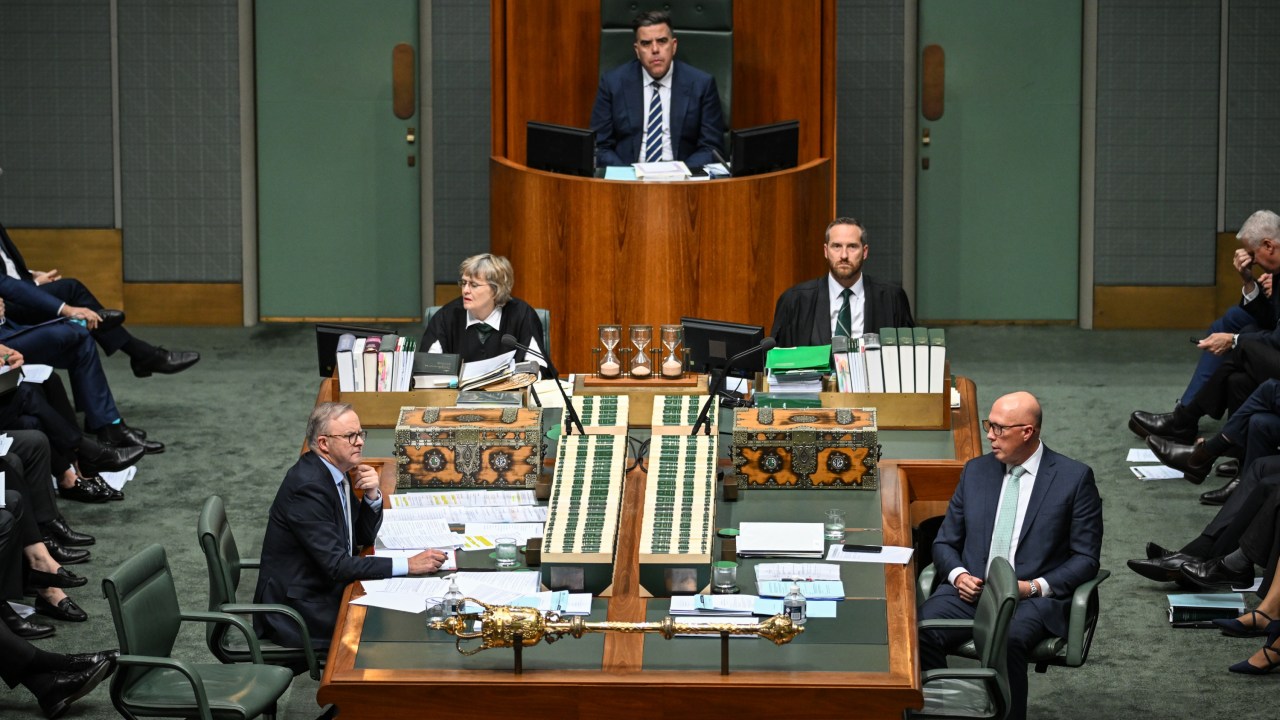Support for the federal Coalition has lifted over Labor for the first time in the key election battleground state of New South Wales, while strengthening even more in Queensland.
Labor continues to lead in Victoria and South Australia, but the gap between the two major parties has shrunk.
A Newspoll commissioned by The Australian released on Sunday has reflected a tightening political contest over the past quarter as Labor now has only a marginal lead over the Opposition overall, with a reduced two-party-preferred vote of 51-49.
The Coalition now leads Labor in NSW on a 51-49 per cent basis after drawing neck-and-neck in the previous quarterly analysis for January-March.
The Opposition’s lead in Queensland also increased to 54-46 in favour of the LNP, compared to the previous two-party-preferred split of 53-47.
Support for the Coalition also rose in Victoria, gaining three points and rising to 36 per cent compared to Labor’s stagnation at 33 per cent.
It marks the first time the Coalition has a majority support among male voters, while female voters marginally back Labor.
However, the Coalition has dropped significant numbers in Western Australia, which was fundamental in Labor’s 2022 election victory, losing its two-party-preferred vote lead of 51-49, as the primary vote fell for the Opposition from 39 to 37, as Labor’s remained stable at 34 per cent.
In Queensland, Opposition leader Peter Dutton has floated above Prime Minister Anthony Albanese as the preferred prime minister.
Overall, Mr Albanese leads Mr Dutton as the preferred prime minister with a 12 point margin of 48-36.
The Australian reported the results confirmed the trend that if an election were held Labor would be forced into a minority government with independents with the prospect of losing two seats in NSW and the potential of one in Queensland.
Among young voters, Labor has lost significant support as the 18-34-year-old demographic decidedly left in droves towards the Greens with the primary vote falling three points to 30 per cent.
Among 18-34-year-old voters, the support for the Greens has risen to 27 per cent, which is on par with the support for the Coalition, which poses a near even split among the three parties as issues such as climate change, rental affordability and the cost of living, as well as the war in Gaza mobilising voters within the younger demographic.
Aside from the voter split along the lines of gender, the poll garnered interesting results along the lines of education status, working status, religion and income, presenting noticeable separations between parties in voter support.
Comparatively, as household income rose, support for the Coalition increased, while support for Labor fluctuated from 34 per cent in households with income between $50k-$99k, down to 31 per cent in households with income between $100k-$149k.
Retirees were more in favour of the Coalition, with a two-party-preferred vote of 47-33, compared to those who were unemployed, where Labor was favoured with a split of 30-26.
The Greens were also predominantly favoured by voters who were working part time or not at all.
Those who attended university were more likely to support the Coalition and the Greens, compared to voters who attended TAFE and were technically educated, who were less supportive of the Greens and more in favour of Pauline Hanson’s One Nation.
Pauline Hanson’s One Nation lifted considerably in Queensland from seven to 10 per cent, remaining steadfast and strong in South Australia, rising two points to 12 per cent.
The most notable and significant result from the two-party-preferred poll on a state-by-state basis is the Coalition’s boost in support in NSW, the largest state, in the April to June period.
However, support for the Greens, rising from eight to 11 per cent has garnered a two-party-preferred lead in Labor’s favour of 52-48.
Mr Albanese’s national approval rating improved slightly from minus eight to minus six compared to the last survey, improving in Victoria while slipping deeper into the negatives in Queensland with a net negative approval rating of minus 16.
Mr Dutton’s approval rating in Queensland, his home state, was also low at minus six, despite leading Mr Albanese there as the preferred prime minister for the first time.
The national average for Labor’s primary vote was 33 per cent, compared to the Coalition on 38 per cent, reflecting a one-point lift for the Opposition while Labor remained unchanged.
The quarterly analysis Newspoll survey was conducted between April 15 and June 26 with 4,957 voters throughout Australia interviewed online with individual state samples ranging from 368 voters, to 1,567.

